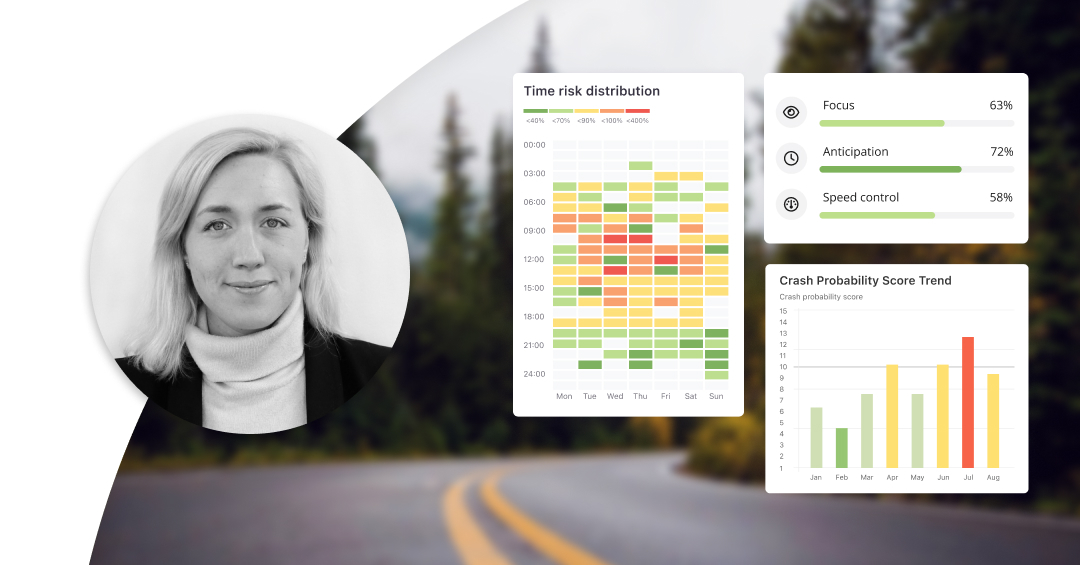
What’s different about our driving scores?

Driving scores are commonplace in the world of telematics. But are they adequate for the evolving needs of today’s fleet customers? As more telematics providers – as well as other consumers of GPS data – look for ways to enhance their current driving scores to stay ahead of their competitors, the focus is on new technology, in particular AI.
Here, I will explain how Greater Than’s AI-generated driving scores differ from the most common scores on the market today, and how they can be quickly and easily integrated into telematics solutions to take driver scoring to a new level.
It’s not all about “events”
Typically, some of the main components of a driving score include acceleration, braking, cornering, idling and speed, with black box devices, smartphones, or other devices, used to measure these “events”. Some driving scores will consider other factors such as time of day and mileage driven.
Our AI-based scoring is much more complex. We have two “core” scores. The first, our Crash Probability Score, takes into account many factors including a driver’s focus, anticipation and vehicle control, as well as surroundings and skill inconsistencies. Together, these factors determine a driver’s likelihood of being involved in a crash (indicated on a 1-15 level).
Our other core score is our Climate Impact Score (1-5), which uses similar factors to determine the driver’s influence on fuel consumption, energy use and hence emissions from high and low. From this, we can also calculate a driver’s percentage of climate impact avoided, and CO2 emissions in absolute terms (grams).
Neither score uses “events” to determine risk level or climate footprint; instead they look at trips holistically, by identifying patterns in driving behavior and comparing these to our 20-year database of over 7 billion driving profiles.
Enabling development of new products
Traditional driving scores might have been excellent for the purpose they were originally intended, but times are changing fast. Customers today want more from their data, and they want driving scores that reflect their most pressing business challenges.
Undoubtedly, one of the biggest such challenges is managing sustainability and ESG reporting, resulting in fleet customers seeking new products that support them in these areas. Note that a score that assumes smooth braking and acceleration automatically equates to eco-friendly driving isn’t enough.
Here’s where our Climate Impact Score is different: it specifically measures climate impact – independent of safety performance – providing companies with the data they need to be transparent to all stakeholders and supply the traceability data required by ESG reporting regulations. Read more about the Climate Impact Score.
Looking to the past or the future?
Many driving scores are based on trips that have already happened to evaluate how a driver handles their vehicle. There’s nothing wrong with that; in fact, some of our scores measure trips that have happened to provide an overview of risk level.
However, our Crash Probability Score is very different. Its purpose is to determine which drivers are most likely to crash, what type of crash it will be, and why. The score uses real-time information during a trip that occurs below the level of event detection – continuously monitoring how the driver is handling the vehicle – creating a holistic view of driving patterns. Then, we instantly correlate these patterns to known outcomes such as crashes and even the type of crash.
The difference between a typical driving score and this predictive type of score is that it can be easily aggregated to show the drivers in a fleet who are most and least likely to crash in the coming weeks. And, leading onto the next point, this makes a predictive driving score highly actionable.
How actionable is your driving score?
Typical driving scores can only provide a certain level of insight, and this limits the corrective actions that can be taken. Check out my recent blog post to learn more about what I mean by actionable driving data.
I know from many conversations with telematics and insurance industry professionals that a common challenge is being unable to specify what type of risk a fleet has, and what action to take.
Our driving scores are actionable for many reasons, including:
- Easy identification of highest and lowest risk drivers
- Ability to see trends such as risk by day or time
- Benchmarking within fleet or at world level
- Identification of factors contributing to the scores
- Quantified climate impact
As well as detailed data insights, our tools clearly show which drivers are most in need of training, reasons why, and provide recommendations for improvement.
Ability to benchmark
This is a critical area for many end users. With an events-based score it’s highly unlikely that you can benchmark drivers if they use different vehicles and/or drive in different geographical locations. AI can change that.
Our scores harmonize data from any source, vehicle type or location so they are easily comparable, enabling benchmarking across any fleet – including those with global operations – as well as benchmarking across industries and countries.
Integration and connectivity
There are many types of technology that can be used to generate the data required for driving scores, including black boxes, connected vehicles and, probably today’s most popular option, the smartphone.
The way our driver scoring is different here is that it can be integrated into any technology, and can be used as a hidden layer in existing solutions. So, if you have a product you’re happy with overall, but would like to benefit from enhanced driver scoring, we can do that! All that’s needed is an API connection, and we can analyze GPS driving data from any device or solution.
Our driving scores can be returned to you within your own program, offering a seamless solution for your fleet customers. Alternatively, you can login to our platform, or we can develop an entirely new white label app. Whatever works best for you and your customers!
Hopefully this blog post has helped you to understand what makes our AI-based driving scores different and how you can benefit from our scoring to enhance your existing solution.
I’d love to provide a no obligation walk-through of our driver scoring so please don’t hesitate to get in touch.



